

This article
was sponsored by
Les Gobbett of the
Leicester Enthusiasts
Following the popular success of the RM6 Runabout from May 1963, Raleigh sought to expand on the theme, and announced the RM8 model in December ’63, for introduction from March ’64. Succeeding the earlier RM4 Automatic model, which became struck off the previous month, the ‘8’ was still a basic single-speed Runabout, painted in a blue & pearl grey (white) scheme, but with the rigid fork and calliper block brake replaced by telescopic forks and hub brake, plus a Wipac headlamp. For all this you paid £62-0s-0d. An extra £15-5s-6d, which was a third as much again! Quite a lot when one considers the bargain basement RM6 was only £46-14s-6d. The introduction of the RM9 Ultramatic in April 1964 however, was a real transformation for the Runabout. This brought in a swing engine with variator gear set, better acceleration and hill climbing abilities, faster cruising, slightly higher top speed, and better economy. RM9’s price was listed at £69-5s-0d, a further 12% increase on the RM8.
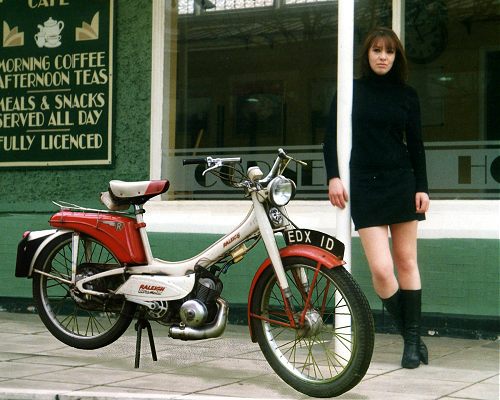
Promotional blurb also claimed 2bhp output from the motor, but it’s hard to figure how this was achieved since it seems exactly the same specification as the 1.7bhp RM6, with standard ‘split fin’ barrel, 7.5:1 compression, and AR10mm carburettor. The switch to a ‘blunderbuss’ exhaust system certainly isn’t going to account for the increase, so it’s probably down to marketing imagination! Visually, all the 6, 8, & 9 Runabouts looked pretty similar, so to emphasise the model’s distinctiveness, only the RM9 was painted in red/pearl grey (white) scheme.
The key to facilitate the swing engine requirement in the fixed motor Runabout frame, was to mount compact metalastic bushes within the head brackets, though Raleigh only adopted fittings that Motobécane already used for existing continental models.
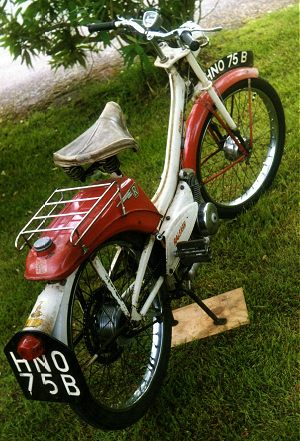
Our first test machine is a fine early example of the model as first
produced, without shrouds on the forks, and fitted with the accessories of
a Huret handlebar mounted speedo set and a chrome tank rack. On the
Runabout, the rack really does matter to the discerning owner, since it
creates a lifting point for getting on and off the stand. Without a
rack, there is no natural hand-hold on the bare tank, so the bike never
feels comfortable in stand operation. The type of rack on this
example is made from ¼" diameter bar, feels solid and comfortably satisfies
its purpose, though doesn’t seem to have appeared among Raleigh accessory
listings, so at this time we’re unsure of its origin.
[A year and a bit after this was published, we
found out the story behind this
rack.]
Registered on 14th December 1964, this bike still wears its original number, complete with old logbook, and showing the current keeper as only the third owner in 42 years.
The engine has been rebuilt with the ‘M’ series 3-ball clutch (in place of the original 4-ball), which better effects variator change action, and some compression ratio increase, but is still fairly representative of the type.
Starting—fuel on tap at bottom offside of tank, twist forward the Amal throttle to decompress, and pull in the choke trigger. You need a firm kick forward on the pedal to overcome all the chain drive ratios and get the engine turning, then time it just right to twist back the throttle as the engine spins. It may well take two or three attempts before the engine catches, then feather the choke trigger a couple more times until the motor runs free.
Tick-over quickly settles down to a nice regular beat. Pull away is quite smart due to the lower starting ratio, and acceleration is a constant urge up the range as the variator smoothly progresses with revs.
Having only covered some 200 miles since its rebuild, this engine is unlikely to have fully bedded in yet, so is probably not expected to be delivering peak performance.
The pace bike recorded 30-31mph on the flat into a light headwind, 32-33mph on the flat with light tailwind, and shallow downhill a best of 35mph, while the Huret 60mph accessory kit speedo reading accurately matched the pace bike.
The RM9’s big 4" rear drum brake feels firm and delivers good stopping power, and though the smaller front brake proved less effective, it was still quite adequate for the performance. Handling was again quite acceptable for the performance, the difference of the tele sprung fork set being more appreciable as the pace picks up on bumpy roads, in comparison to the rigid fork RM6. The RM9’s larger Wipac 15/15W headlamp delivers a better light than the smaller Sturmey-Archer headlamp of the RM6 and, despite the beam scatter, you do notice some improvement on the dark country lanes.
The transformation that the variator makes can be appreciated by analysing the effect it has on the drive ratios. Where the RM6 Runabout has only a single-speed final drive ratio of 13.8:1, the RM9 variates from 18.74 (low) to 11.4 (high). This means that for pull away and hill-climbing the RM9 has a 35% lower ratio advantage, and for top speed and economy operates a 16.5% higher ratio.
Fork shrouds and a chainguard were added to the RM9 in early 1965, resulting in the type 2 variant.
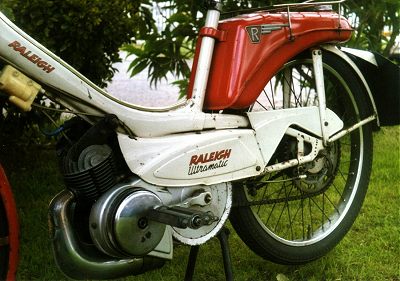

Correctly featuring the fork shrouds, our second test machine is a later example of the RM9 MkII, registered 8th March 1966, and is only on its second owner! Notice the drive chainguard—an addition that was probably prepared in anticipation of the RM9+1 dual seat version of the Runabout family introduced on November 1966, to prevent any passenger clothing contact with the driving chain or rear sprocket. The detail of the chainguard matches to the style of the pressed steel side panels, but give the guard a tap with your fingernail, and surprise—it’s plastic!
This RM9 still wears its original two-tone saddle cover, in white with a red nose to match the paint scheme. It also illustrates the other tank rack form found on Runabouts, a different shape made from chromed 3/16" wire and posted at 15s-6d among the Raleigh accessories. You notice the thinner rod diameter when you naturally lift by the rack during stand action, and it doesn’t feel so nice as the other type. Raleigh’s supplier of carriers was listed as Wistonia Ltd, Saltcotes Road, Lytham St Annes, Lancs, and were certainly the source of the ‘official’ rack.
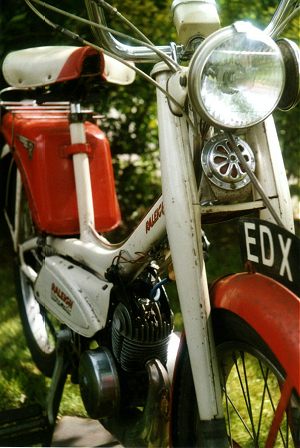
This second test machine seems a little more free-revving than our first example, and holds the edge on acceleration when we run the two together. The pace bike clocks 32-33mph on the flat into a light headwind, 35-36 mph on the flat with a light tailwind, and shallow downhill momentarily glimpses a very best of 38mph. At these higher speeds, vibration was more evident than on the first machine. The speedo was also a little more optimistic, reading over 40 on the clock.
The 1966 Raleigh catalogue introduced a new monotone colour scheme for the RM9, in ‘Polychromatic Golden Sand’.

The RM9+1 joined the listings from November 1966, in a Calypso Coffee & Pearl Grey ‘reversed scheme’, in that the frame and panels appeared in the darker tone, however this format was fairly short lived, as the colour had changed to Royal Carmine Red from March 1968.
The RM11 Super Tourist and RM12 Super 50 were discontinued in July 1967.
At the end of June 1969, Raleigh’s owners, Tube Investments, delivered the bombshell news to its employees in the Motorised Division that they were all on 3 months’ notice of redundancy, and that all powered products were to be dropped. The RM9 Ultramatic was officially discontinued from production in September 1969, along with the RM5 Supermatic, Wisp, RM8, and RM9+1; with a revised frame numbering system, only the faithful RM6 Runabout soldiered on to burn off stocks, until January 1971, when the last Raleigh moped officially disappeared from the lists.
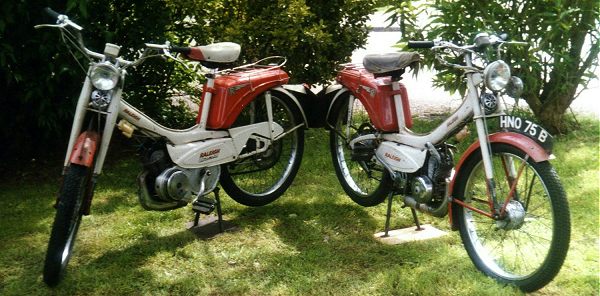
Compared to the RM6, the RM9 cost very nearly half as much again. In 1964, a further £23 was a lot of money, and people wouldn’t have gone out and spent that extra on a Runabout without reasonable consideration. In the Runabout family, only the RM9+1 was more expensive, with its dual seat and pillion footrests, the price tag was £73-3s-8d. Today, nobody seems to equate these value differentials to the second-hand moped market, and all the Runabout models reflect similar prices. So if you’re off to buy a Runabout, take the trouble to seek out an RM9 (or especially an RM9+1), and get a lot more value for your money.
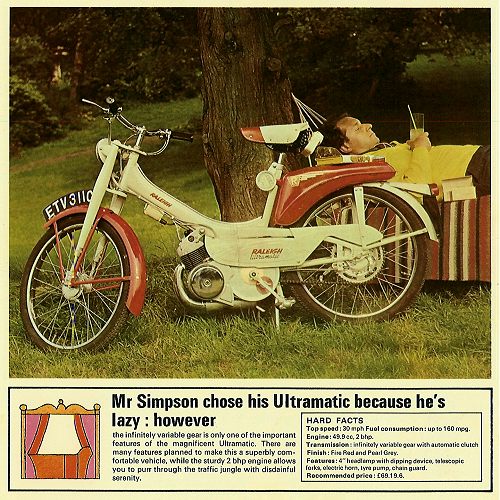
Next: All other marques are winding up their manufacture over this turbulent period, so 1940 would hardly seem like the most suitable time to announce a new autocycle. It wasn’t! But the smith’s mighty arm is raised to strike a hammer-blow, and by the end of the decade this would become the market-leading brand.
This article appeared in the January 2008 Iceni CAM Magazine.
[Text & photographs © 2008 M Daniels.
Montage © 2008 A Pattle]
Even with the article conveyor belt turned off back in 2005, the opportunity of two good and original Raleigh RM9s from Martin Gates and Alex Lees was a chance not to be missed, despite knowing it was going to be yet another article, just sitting in the can, biding its time and waiting for better days. When we came to shake down the draft for IceniCAM 4 some two years later, things had moved on, with IceniCAM features evolved to contain appreciably more content than was the usual practice with the limitations of earlier publications. Though a complete and compact little text file, it still didn’t have a title, and it now looked far too small to stand as lead feature in IceniCAM, so there was another re-write to build in further content. The photoshoot was completed back in October 2005, though popular model Rhoda Miles from earlier Raleigh articles Ruby Runabout and Tourist Season wasn’t available for this set. It just wouldn’t have felt right featuring a Raleigh without Rhoda, so we put her in anyway!
Well, there was a number of leftover shoots from an earlier set that never got used, so Andrew digitally cut the original bike from the picture, dropped in one of the RM9s, and spent ages painstakingly finishing the fine detail so it wouldn’t be obvious. Did anyone spot it? No, of course you didn’t, you were too busy looking at Rhoda again!
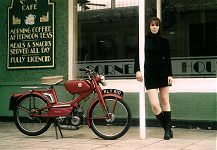
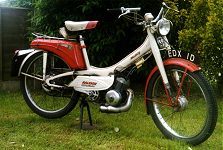
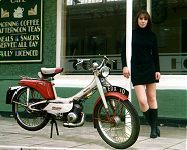
Total production cost for the article was £31 (£23 fuel, + £8 film and developing). The RM9 made an interesting comparative to the rest of the Runabout family, particularly on cost and technical features, and from a list of prospective titles, ‘What’s in a number?’ seemed the most suitable.
Particular thanks for assistance with the Raleigh research from Brian at Aplins, and Les Gobbett of the Leicester Enthusiasts, who also scored the sponsorship credit. Les has been a long time supporter of the feature article, and had a couple of his own machines previously featured in Olympian Chariot and Ruby Runabout (becoming the envy of all his colleagues in meeting the delectable Rhoda on the photoshoot), so there was natural interest in supporting the RM9 to publication.
| CAMmag Home Page | List of articles |